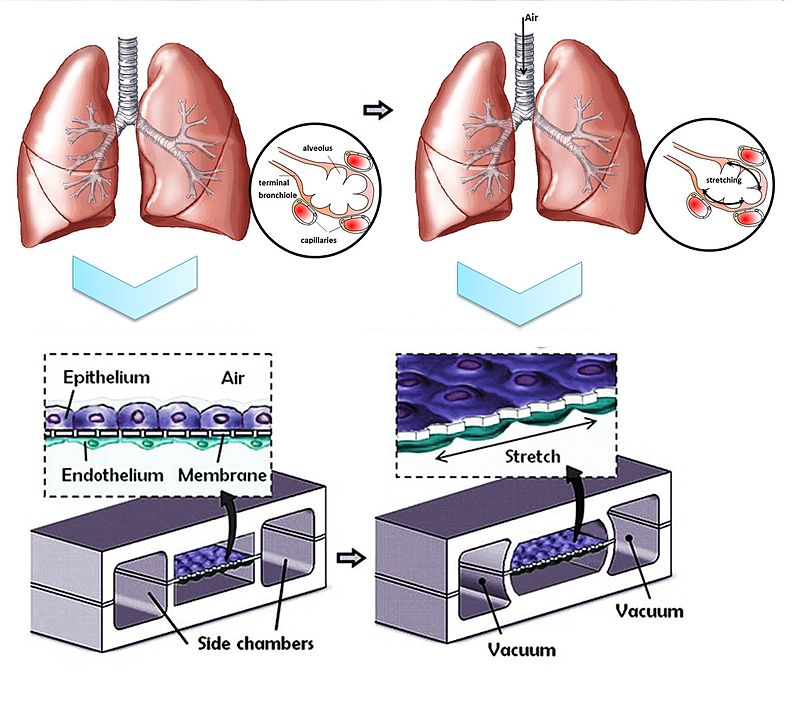Lung-on-a-chip on:
[Wikipedia]
[Google]
[Amazon]
 Lung-on-a-chip (LoC), also known as Lung Chips, are micro- and millifluidic organ-on-a-chip devices designed to replicate the structure and function of the human lung, mimicking the breathing motions and fluid dynamics that occur during inhalation and exhalation. LoCs represent the most promising alternative to replace
Lung-on-a-chip (LoC), also known as Lung Chips, are micro- and millifluidic organ-on-a-chip devices designed to replicate the structure and function of the human lung, mimicking the breathing motions and fluid dynamics that occur during inhalation and exhalation. LoCs represent the most promising alternative to replace
 Lung-on-a-chip (LoC), also known as Lung Chips, are micro- and millifluidic organ-on-a-chip devices designed to replicate the structure and function of the human lung, mimicking the breathing motions and fluid dynamics that occur during inhalation and exhalation. LoCs represent the most promising alternative to replace
Lung-on-a-chip (LoC), also known as Lung Chips, are micro- and millifluidic organ-on-a-chip devices designed to replicate the structure and function of the human lung, mimicking the breathing motions and fluid dynamics that occur during inhalation and exhalation. LoCs represent the most promising alternative to replace animal testing
Animal testing, also known as animal experimentation, animal research, and ''in vivo'' testing, is the use of animals, as model organisms, in experiments that seek answers to scientific and medical questions. This approach can be contrasted ...
.
Concept
Huh et al. developed the firstpolydimethylsiloxane
Polydimethylsiloxane (PDMS), also known as dimethylpolysiloxane or dimethicone, is a silicone polymer with a wide variety of uses, from cosmetics to industrial lubrication and passive daytime radiative cooling.
PDMS is particularly known for its ...
(PDMS)-based microfluidic system for culturing primary diseased small airway epithelial cells at the air-liquid interface (ALI). Despite its simplicity, this system successfully replicated crackling sounds associated with mechanical injury in the airway lumen.
The first LoC, published in the June 25, 2010, issue of ''Science
Science is a systematic discipline that builds and organises knowledge in the form of testable hypotheses and predictions about the universe. Modern science is typically divided into twoor threemajor branches: the natural sciences, which stu ...
,'' was developed by Dan Huh and Donald E. Ingber at the Wyss Institute using a microfabrication
Microfabrication is the process of fabricating miniature structures of micrometre scales and smaller. Historically, the earliest microfabrication processes were used for integrated circuit fabrication, also known as "semiconductor manufacturing" ...
technique called soft lithography
In technology, soft lithography is a family of techniques for fabricating or Replication (disambiguation), replicating structures using "elastomeric stamps, molds, and conformable photomasks". It is called "soft" because it uses elastomeric mate ...
, which was pioneered by George M. Whitesides. A typical alveolus LoC comprises two microchannels primarily lined with epithelial cells on the apical side and endothelial cells on the basal side. Air is delivered to the lung lining cells, a culture medium flows in the capillary channel to mimic blood, and cyclic mechanical stretching is generated by a vacuum applied to the chambers adjacent to the cell culture channels to mimic breathing. The device is made using human lung and blood vessel
Blood vessels are the tubular structures of a circulatory system that transport blood throughout many Animal, animals’ bodies. Blood vessels transport blood cells, nutrients, and oxygen to most of the Tissue (biology), tissues of a Body (bi ...
cells and it can predict absorption of airborne nanoparticle
A nanoparticle or ultrafine particle is a particle of matter 1 to 100 nanometres (nm) in diameter. The term is sometimes used for larger particles, up to 500 nm, or fibers and tubes that are less than 100 nm in only two directions. At ...
s and mimic the inflammatory response triggered by microbial pathogen
In biology, a pathogen (, "suffering", "passion" and , "producer of"), in the oldest and broadest sense, is any organism or agent that can produce disease. A pathogen may also be referred to as an infectious agent, or simply a Germ theory of d ...
s. It can be used to test the effects of environmental toxins, absorption of aerosolized therapeutics, and the safety and efficacy of new drugs.
Since the introduction of LoCs in 2010, numerous advancements have been made to develop valid, functional, and clinically relevant models.
Shortcoming
The breathing movements in typical LoC such as Wyss platform occur in 2D, rather than the physiologically relevant three-dimensional (3D) format. Most organ-on-chip models, including LoC, are made from PDMS, which has several limitations. For example, the two-compartment platform chip, similar to the Wyss chip, is at least 10-15 times thicker than its ''in vivo'' counterpart (the commercial Wyss chip has a thickness of 50 μm according to its datasheet). This increased thickness is significant because it impedes the cross-talk between the two sides of the PDMS membranes. The main issue with PDMS is itsadsorption
Adsorption is the adhesion of atoms, ions or molecules from a gas, liquid or dissolved solid to a surface. This process creates a film of the ''adsorbate'' on the surface of the ''adsorbent''. This process differs from absorption, in which a ...
properties, which lead to unrealistic ADME
ADME is the four-letter abbreviation (acronym) for absorption (pharmacokinetics), ''absorption'', distribution (pharmacology), ''distribution'', ''metabolism'', and ''excretion'', and is mainly used in fields such as pharmacokinetics and pharmacol ...
and, consequently, inaccurate pharmacokinetics
Pharmacokinetics (from Ancient Greek ''pharmakon'' "drug" and ''kinetikos'' "moving, putting in motion"; see chemical kinetics), sometimes abbreviated as PK, is a branch of pharmacology dedicated to describing how the body affects a specific su ...
analysis. Other limitations of PDMS include biodegradation
Biodegradation is the breakdown of organic matter by microorganisms, such as bacteria and fungi. It is generally assumed to be a natural process, which differentiates it from composting. Composting is a human-driven process in which biodegrada ...
, leaching, cell delamination, and molecule absorption, all of which affect the accuracy and reliability of cell assays.
References
{{Reflist Lung Biotechnology